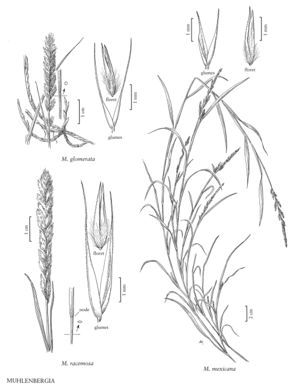Muhlenbergia racemosa
Plants perennial; rhizomatous, not cespitose. Culms 30-110 cm tall, 1-1.5 mm thick, stiffly erect, much branched above the middle, internodes mostly smooth, polished, glabrous or puberulent immediately below the nodes, elliptic in cross-section and strongly keeled. Sheaths scabridulous, slightly keeled; ligules 0.6-1.5 (1.7) mm, membranous, truncate, lacerate-ciliolate; blades 2-17 cm long, 2-5 mm wide, flat, usually scabrous or scabridulous, occasionally smooth. Panicles 0.8-16 cm long, 0.3-1.8 cm wide, lobed, dense; branches 0.2-2.5 cm, appressed; pedicels absent or to 1 mm, strigose. Spikelets 3-8 mm. Glumes subequal, 3-8 mm (including the awns), about 1.3-2 times longer than the lemmas, smooth or scabridulous distally, 1-veined, acuminate and awned, awns to 5 mm; lemmas 2.2-3.8 mm, lanceolate, pilose on the calluses, lower 1/2 of the midveins, and margins, hairs to 1.2 mm, apices scabridulous, acuminate, unawned or awned, awns to 1 mm; paleas 2.2-3.8 (4.5) mm, lanceolate, intercostal region loosely pilose on the lower 1/2, apices acuminate; anthers 0.4-0.8 mm, yellowish. Caryopses (1.2) 1.4-2.3 mm, fusiform, brown. 2n = 40.
Distribution
Wash., Wis., Maine, N.H., Wyo., N.Mex., Tex., N.Y., Nev., Va., Colo., Alta., B.C., Man., N.S., Ont., Que., Sask., Kans., N.Dak., Nebr., Okla., S.Dak., Vt., Ill., Ind., Iowa, Ariz., Idaho, Utah, Mo., Minn., Mich., Mont., Ky., Oreg.
Discussion
Muhlenbergia racemosa grows on rocky slopes, beside irrigation ditches, in seasonally wet meadows, on the margins of cultivated fields, railways and roadsides, in prairies, on sandstone outcrops, on stream banks, and in forest ecotones at elevations of 30-3400 m. It is most common in the north central United States, but can be found at scattered locations throughout the western United States, and extends into northern Mexico.
Selected References
None.
Lower Taxa
"decumbent" is not a number.
